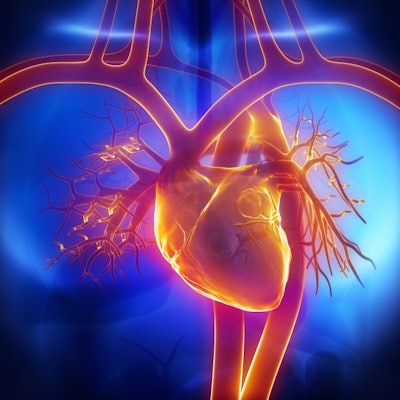
Routine mammograms could help clinicians assess women's cardiovascular disease risk by identifying calcifications in breast arteries, according to a study published March 15 in Circulation: Cardiovascular Imaging.
The study findings could make assessing and tracking women's heart disease risk more effective, said lead author Dr. Carlos Iribarren, PhD, of Kaiser Permanente in Oakland, CA, in a statement released by the American Heart Association (AHA), the journal's publisher.
"Our study has moved the needle toward recommending routine assessment and reporting of breast arterial calcification in postmenopausal women," he said. "Integrating this information in cardiovascular risk calculators and using this new information can help improve cardiovascular risk reduction strategies."
Calcium buildup in the breast arteries is related to aging, Type 2 diabetes, high blood pressure, and inflammation, and can indicate arterial stiffening -- a risk factor for heart disease and stroke but not a cancer marker, according to the AHA statement.
How women are assessed for cardiovascular disease risk could be improved, Iribarren said. And breast artery calcification on mammography is not always reported.
"Research has confirmed the calculators we currently use to assess an individual's 10-year risk of developing cardiovascular disease are not as accurate in women as they are in men ... [and] currently, it is not the standard of care for breast arterial calcification visible on mammograms to be reported," he said.
In an earlier study conducted by Iribarren's group, the team found that 26% of women between the ages of 60 and 79 had breast arterial calcification on mammography, and this percentage increased to 51% among women aged 75 to 79.
Building on this research in their new study, the authors reviewed health records of more than 5,000 women who underwent screening mammograms as part of MINERVA (Multiethnic Study of Breast Arterial Calcium Gradation and Cardiovascular Disease); the women were between 60 and 79 and received at least one digital mammography screening exam at a Northern California Kaiser facility between October 2012 and February 2015. None of the study participants had prior history of heart disease or breast cancer. They were tracked for 6.5 years after the mammogram for heart attack, stroke, or heart failure.
The group found the following:
- Women with breast artery calcifications on mammography were 51% more likely to develop heart disease or have a stroke compared with those who did not.
- Women with breast artery calcifications on mammography were 23% more likely to develop any type of cardiovascular disease, including heart disease, stroke, heart failure, and diseases of the peripheral arteries.
- White or Hispanic/Latina women were more likely to have breast arterial calcification on mammography than their Black or Asian counterparts.
"Our analysis ... demonstrates that presence of breast arterial calcification in mammograms is independently related to incident atherosclerotic cardiovascular disease and to global cardiovascular disease, and therefore, adds to the body of evidence that assessment and reporting of breast arterial calcification status has potential utility to change clinical practice and impact primary cardiovascular disease prevention for women," the investigators noted.
Breast cancer is a serious and common disease, but cardiovascular disease is even more prevalent among U.S. women, wrote Dr. Natalie Cameron and Dr. Sadiya Khan, both of Northwestern University in Chicago, in an accompanying editorial. That's why the study findings show such potential.
"Iribarren et al's study is an important addition to a large body of literature examining the promise of imaging markers for early detection of subclinical cardiovascular disease ... to guide prevention efforts," they wrote.



















